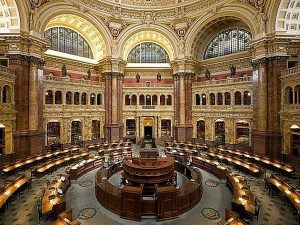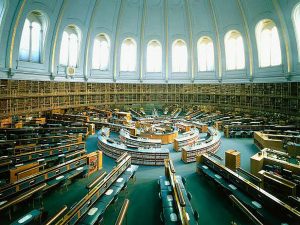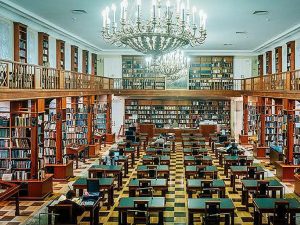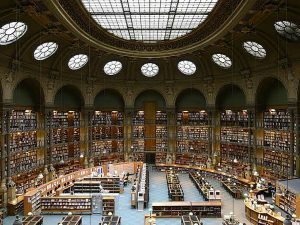Largest Libraries In The World: The purpose of this article is to inform, educate, and entertain you about the world’s largest libraries and their locations. The term “library” today appears to be used in a variety of contexts, ranging from the traditional public library to the digital library. Libraries are vibrant spaces where librarians assist patrons in locating the finest source of information, whether it’s a book, a website, or a database entry.
A library is a structure or room that houses a collection of books, periodicals, and occasionally films and recorded music that can be borrowed or used by the general public or members of a particular institution. It can also be defined as a space set aside for the storage of books, magazines, and other reading, viewing, listening, study, or reference materials. We’ll tell you about the top fourth largest libraries in the world in this article.
Recommended: Countries with the best Education system in the world
Top 14 Largest and Biggest Libraries in the world 2024
1. Library of Congress, United State: The Library of the United States of America is also the world’s largest library. The National Audio-Visual Conservation Center, a distinct campus in Virginia, is a federal institution on Capitol Hill in Washington, D.C. The library has study materials from all over the world in its collection.

The Library of Congress has 450 languages from around the world on display. In Washington, D.C., the library opened its doors. The library, which opened in 1800 in Washington, D.C., has been damaged and destroyed multiple times, including by the British in 1814 during the War of 1812 and a roaring fire in 1851.
After the American Civil War, it flourished and expanded, and it began collecting books and major publications from all over the world. Even though the library is open to the public for tours, only high-ranking government officials have access to its volumes and materials nowadays. The library is involved in several projects aimed at promoting American literature and art.
2. The British Library, United kingdom: With a collection of 150 million books, manuscripts, journals, music recordings and scores, patents, databases, and other items, the British Library is the world’s second-biggest library.

The National Library of the United Kingdom is located in London, between the Euston and St. Pancras train stations. On July 1st, 1973, the British Library Act 1972 established the library as a separate organization.
The Diamond Sutra, the world’s first printed publication, a notebook by Leonardo da Vinci, Codex Arundel, Gutenberg Bibles, and Lewis Carroll’s famous manuscript of Alice’s Adventures Under Ground is among the library’s remarkable treasures.
Also see: How to become a successful business woman
3. New York Public Library, United States: The New York Public Library system is known around the world for its large collection of 55 million items, which includes books, journals, musical records, and other publications and albums.

The formation of this huge network of libraries, which is today sponsored by both government and private institutions, originated from the amalgamation of small and large libraries, including libraries of book enthusiasts and affluent millionaires in New York.
The library’s main branch, at the corner of Fifth Avenue and 42nd Street in New York, is open to the public. The National Historic Landmark designation was given to it in 1965. The New York Public Library now has four research libraries, as well as branches in the Bronx, State Island, and Manhattan, as well as several smaller libraries.
4. Library and Archives Canada: The Library and Archives of Canada, the world’s fourth-biggest library, is run by Canada’s federal government. The institution has been entrusted with the monumental duty of conserving Canada’s heritage documentaries and making them accessible to the general public. Nearly 20 million books, 24 million images, private and government archives, aboriginal magazines, non-fiction and fiction films, Canadian journals, and more are among the present holdings.

The announcement of the Canadian Constitution Act, the first-century book by historian Flavius Josephus, Glenn Gould’s chair, and the British North America Act are among the library’s most cherished possessions. The National Library of Canada and the National Archives of Canada merged in 2004 to become the Library and Archives of Canada, which reports directly to the country’s Parliament.
Also see: Best time to read and understand effectively
5. Russian State Library, Russia: The Russian State Library is the world’s sixth-largest library. Every Russian publication has at least one copy in this library.

The library now houses 17 million volumes, 13 million periodicals, 150,000 maps, and thousands of music albums and scores, among other things. Fedorov Alexander I Visually, Vladim Gnezdilov, and Viktor V. Fedorov are the directors of one of the world’s largest libraries.
There are also products in 247 different languages from throughout the world, with the foreign section accounting for around 29% of the whole collection. The Russian State Library is located in Moscow, the country’s capital, and is open to the general public. It was established on July 1, 1862.
6. Bibliotheque Nationale De France: This library, which is ranked sixth, has a total of 40 million books and is one of the world’s largest libraries. This library was constructed in 1368 in Paris, France, when Charles V established a royal library at the Louvre Palace, but it was eventually lost.

However, in 1461, Louis XI started a new one, which subsequently enlarged and became open to the public in 1692. It was developed and established under the direction of the Ministry of Culture to store copies of work published in France.
This particular library, which was named the world’s largest library in 1896, adds roughly 150.000 documents to its collection each year. The volumes survived the French Revolution thanks to the efforts of a few librarians and experts. It currently has a $288 million annual budget and approximately 1.3 million annual visitors.
Also see: How to read for long hours Without getting tired
7. National Diet Library, Japan: The National Library of Japan is the country’s sole one. In 1948, the National Diet Library was founded to serve members of Japan’s National Diet. KYOTO and TOKYO have access to the National Diet Library’s services. There are 34.7 million items in the library’s collection. Sawako Hanyu is in charge of the library. A microform collection of 30 million pages of records relating to Japan’s occupation following World War II is among the library’s most important holdings. The National Library of Medicine (NDL) houses a collection of 530,000 science books.

Modern Political and Constitutional History, Materials Concerning Japan’s Postwar Occupation, Laws and Preliminary Records, Science and Technology, Maps, Music, Foreign Books on Japan, and Rare Books are among the eight major specialty collections housed at the National Diet Library.
8. National Library of China: This library in Beijing, China, was founded on September 9, 1909, but it was publicly launched in 1912. It is one of Asia’s largest libraries. The Imperial Library of Peking, as it was known when it originally opened in 1912, has a long and illustrious history.

It went through several more name changes after that until it arrived at its current position. This library serves as the People’s Republic of China’s national library and has the world’s largest and most diverse collection of Chinese literature and historical documents. The National Library also has approximately 35,000 Shang era inscriptions on oracle bones and tortoise shells Contains official UN and foreign government publications, as well as a collection of books and materials in over 115 languages.
The National Library of China is said to get around 5.2 million visits each year. A total of 1,365 people work at and maintain the library. This library, which is ranked eighth on our list, has a total of 37 million items.
Also see: How to prepare and pass scholarship examinations
9. Royal Danish Library, Denmark: The beginnings of the Royal Danish Library may be traced back to King Frederick III in the year 1648. It was, nevertheless, opened to the public in 1793. It was combined with the famed Copenhagen University Library and then with the Danish National Library for Science and Medicine, which is today known as the Faculty Library of Natural and Health Sciences.

Books, journals, periodicals, pamphlets, corporate publications, manuscripts and archives, charts, prints and pictures, music scores, and documentation of popular traditions are among the 35,400,000 objects in the Royal Danish Library. The first Danish book, published in 1482 by Johann Snell, is one of the great highlights of the history held in just this Black Diamond-shaped library.
10. German National Library, Germany: The German National Library is one of the world’s largest libraries. It was founded in 1912, making it 107 years old.
The library’s main goal is to archive, comprehensively document, and document bibliographically all German and German-language publications published since 1913, as well as foreign articles about Germany, translations of German works, and works by German-speaking emigrants published abroad between 1933 and 1945, and make them available to the public.
More than 2 lakhs of people use this central archival library, which includes roughly 32.6 million items. It operates out of three locations: Frankfurt, Leipzig, as well as Berlin.
Recommended: Most Respected Countries In The World 2024
11. AUSTRIAN NATIONAL LIBRARY: The Austrian National Library is one of the world’s largest libraries. According to records, the library has about 12 million items in its various collections, making it the biggest library in Austria. The Neue Burg Wing of the Hofburg, in the centre of Vienna, is the prime location for the library. Records also show that some of the collections have been moved within the Palais Mollard-Baroque Clary’s building since 2005. The Imperial Court Library which the Habsburgs founded, was given its current name in 1920, after the end of the Habsburg Monarchy and the founding of the Austrian Republic.

The library complex houses numerous unique collections and archives in addition to four museums. The collection and archiving of all publications occurring in Austria is one of the Austrian National Library’s main duties, which also includes electronic media. Based on the medium’s legal requirements, the National Library must receive four copies as well as two obligation copies from other printing elements on a regular basis when they emerge in Austria. The library also gathers all foreign-published works by Austrian authors as well as any works that are about Austrians or the Austrian way of life.
With an emphasis on the breadth of the Geisteswissenschaften, more publications from the foreign nation are taken up. The development of the existence and their supply in the form of local-loan, remote-loan, and search services, as well as Auskunfts, information, and reproduction services, are tasks and services of the national library. Collaboration with universities, schools, and adult education programmes also complies with the constitutionally mandated general order for education. More than seven million items total in the library, of which about three million are printed.
Also see: Countries With The Best Government In The World 2024
12. UNIVERSITY HOUSE ALEXANDRIA LIBRARY: One of the biggest and most important libraries in the ancient world was the Great Library of Alexandria, located in Alexandria, Egypt. The Library was a part of the Mouseion, a bigger study facility honouring the Muses, the nine goddesses of the arts.

Demetrius of Phalerum, an exiled Athenian statesman who resided in Alexandria, may have suggested the idea of a universal library to Ptolemy I Soter, who may have established plans for the Library; however, the Library itself was most likely not constructed until the reign of his son Ptolemy II Philadelphus.
Due in significant part to the active and well-funded procurement methods of the Ptolemaic kings, the Library swiftly amassed a large number of papyrus scrolls. The exact number of these scrolls stored at any given time is unknown, but during its peak, estimates range from 40,000 to 400,000.
Recommended: Countries With The Best Hackers In The World
13. Bodleian Library: One of the oldest libraries in Europe, the Bodleian Library serves as the primary research library for the University of Oxford. It gets its name from Sir Thomas Bodley, who founded it. After the British Library, it is the second-largest library in Britain with nearly 13 million printed items.

It is one of six legal deposit libraries listed in the Legal Deposit Libraries Act of 2003 for works published in the UK, and under Irish law, it has the right to ask for copies of all books produced in the Republic of Ireland. It is mostly used as a reference library and is referred to by Oxford academics as “Bodley” or “the Bod.” In general, books cannot be taken out of the reading rooms.
14. George Peabody Library: One library affiliated with Johns Hopkins University that specialises in study into the 19th century is the George Peabody Library. It is situated on the Peabody campus at West Mount Vernon Place in the Mount Vernon-Belvedere historic cultural zone, north of downtown Baltimore, Maryland. It was once the Library of the Peabody Institute of Music in the City of Baltimore.

The 300,000 volumes in the library’s collection are particularly strong in the fields of religion, British art, architecture, topography, and history; American history, biography, and literature; Romance languages and literature; history of science; and geography and exploration. The collections are open to the public in keeping with the Baltimore merchant and philanthropist George Peabody’s intention to build a library “for the free use of all persons who desire to consult it.” It remains one of the largest libraries in the world.
Recommended: Most beautiful countries in Africa
Conclusion
I truly hope that this post has been of tremendous assistance to you in the way that you imagined. There has been some argument over which libraries are the largest over time, and these debates have left people perplexed, but not with this article.
I hope that these disagreements will be reduced or eliminated because the libraries listed above are the largest of the libraries in the world. If you enjoyed this post, please share it with your family and friends, and if you have any unanswered questions, feel free to use the comment box.

Edeh Samuel Chukwuemeka, ACMC, is a lawyer and a certified mediator/conciliator in Nigeria. He is also a developer with knowledge in various programming languages. Samuel is determined to leverage his skills in technology, SEO, and legal practice to revolutionize the legal profession worldwide by creating web and mobile applications that simplify legal research. Sam is also passionate about educating and providing valuable information to people.